Last year, when I saw the announcement that a new tabletop radio–the Alinco DX-R8T–was about to hit the market, I almost fell out of my chair.
A new tabletop on the market? Could it be true? Over the past few years, many long-time manufacturers have dropped out of the shortwave tabletop market, while newer, smaller manufacturers have been popping up in the SDR (Software Defined Radio) market. SDRs are great–a lot of performance for the price–but to listen to the radio, you have to turn on your computer, launch a program, and typically, do things to isolate any noise your computer may generate.
A tabletop, on the other hand, simply requires that you turn it on: instantly, it’s there, awaiting tuning.
Obviously, I was eager to try out the DX-R8T. Fortunately, the good folks at GRE America (the US distributor for Alinco) kindly loaned me one of their receivers to review for SWLing.com.
First Impressions
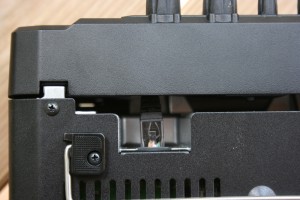
The face plate on the Alinco DX-R8T is detachable (with optional extension cable). This view, from underneath, shows where it plugs into the receiver body.
I really appreciate the size and feel of the Alinco DX-R8T. It’s heavy, with a metal case and a very durable plastic face plate. It has a bail under the front panel which allows it to be lifted and carried for easy tabletop operation.
Please note: If you’re new to tabletop shortwave receivers or ham radio transceivers, be aware that the Alinco DX-R8T is based on the Alinco DX-SR8T ham radio transceiver–and as such, it operates on 12VDC. Meaning, you will need a 12 volt power supply like the Pyramid PS-3 or similar. If you already have a power supply, make sure it can at least deliver 1.5 amps at 13.8V. You do not want to purchase a “wall wart” type power supply, as many of these are noisy and will effect your ability to hear stations. For the purpose of review, I have actually been running the DX-R8T off of a 40AH, 12 V battery to eliminate all such noise.
The tuning knob, which I personally find to be a particularly important feature, is substantial, solid, and moves fluidly–a plus. I have not found a way to adjust the tension/resistance on the tuning knob, but haven’t felt the need to do so, either. The radio is heavy enough that it stays put while tuning and pressing keys, which is also important.
The ergonomics are good. I like how the volume, squelch, IF shift and RIT are all easily accessible single-function knobs.
If I have any criticism of this radio’s ergonomics, it would simply be that several of the buttons are a bit close to the tuning knob. I have larger fingers, so while pushing the Function switch, RIT switch, keylock or turning the RIT knob, I often inadvertently move the tuning knob. But in truth, this is a fairly persnickity observation; in general I’m pleased with the panel layout and ergonomics.
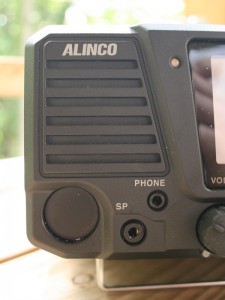 Like the IC-R75, the DX-R8T has a front-facing speaker–always a good thing when listening via a built-in speaker. Admittedly, the overall fidelity of the built-in speaker is mediocre at best–it lacks any bass response and sounds shallow, and unfortunately, there’s no way to change the tone from high to low. While the built-in speaker is fine for listening to the ham radio bands (in SSB or a CW mode), I would like better fidelity for the broadcast bands. This is no doubt a vestige of this radio’s ham transceiver heritage.
Like the IC-R75, the DX-R8T has a front-facing speaker–always a good thing when listening via a built-in speaker. Admittedly, the overall fidelity of the built-in speaker is mediocre at best–it lacks any bass response and sounds shallow, and unfortunately, there’s no way to change the tone from high to low. While the built-in speaker is fine for listening to the ham radio bands (in SSB or a CW mode), I would like better fidelity for the broadcast bands. This is no doubt a vestige of this radio’s ham transceiver heritage.
The front display is large, with an adjustable dimmer. It is crisp and very easy to read, which I like very well.
The competition
The only current shortwave tabletop competitors with the Alinco DX-R8T ($500), are the Icom IC-R75 ($600-700) and the Palstar R30A ($740 US). The Icom IC-R75 is a fine receiver and one I have recommended to many web readers in search of a multi-function tabletop. It has been on the market for years in many versions (some more successful than others), and is generally a solid performer. The Palstar R30A is also an excellent receiver, though it lacks the bells and whistles of its Japanese counterparts. People who buy a Palstar want bare-bones simplicity and performance.
Since I own a Palstar R30C (the predecessor to the R30A), I used it as a point of comparison in my review of the DX-R8T.
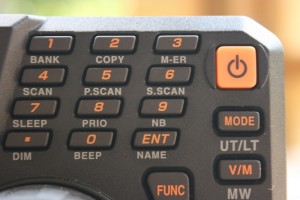
Operation
The DX-R8T is a pleasure to operate. I was able to intuit nearly all but the memory functions without looking at the owner’s manual even once. A major plus, in my opinion!
Tuning is the function you use the most on any radio; with the DX-R8T you have three ways to tune:
- the tuning knob
- the up/down arrows and M/kHz button to toggle steps
- the direct keypad entry
I did find it helpful to use the up/down arrows to move between meter bands, otherwise I never tune with the up/down arrows.
The tuning knob gets my seal of approval and scanning with it is a pleasure. Admittedly, I wish it were a little more adaptive to tuning speed (i.e., turning quickly speeds up the frequency steps) or that it could be adjusted somewhat. You can tell that the Alinco DX-R8T derives from amateur radio, as its tuning knob speed is perfect for finding ham radio stations.
Switching between modes is simple–pressing the “Mode” button moves you between, AM, FM, CWL, CWU, LSB and USB.
Broadcast listening
The Alinco DX-R8T is a capable broadcast receiver. In my tests, it was as sensitive as my Palstar.
The generous, wide 9kHz AM bandwidth means that broadcast stations come in with a great deal of fidelity. The flip side of the 9kHz bandwidth, though, is that it is less effective if there is an adjacent station–say, 5kHz away. Luckily, the DX-R8T has an IF shift knob handy so that a modest adjustment can usually eliminate adjacent interference.
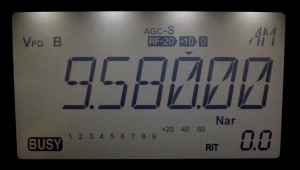 I found the narrow AM bandwidth a little too narrow for broadcast listening. It’s a mere 2 kHz wide and is simply too restrictive if listening to music. For voice intelligibility, the narrow filter works fairly well, using the IF shift to open it a bit. This narrow filter could be useful if trying to snag a weak DX signal, as it’s sufficiently narrow to cut out a lot of noise.
I found the narrow AM bandwidth a little too narrow for broadcast listening. It’s a mere 2 kHz wide and is simply too restrictive if listening to music. For voice intelligibility, the narrow filter works fairly well, using the IF shift to open it a bit. This narrow filter could be useful if trying to snag a weak DX signal, as it’s sufficiently narrow to cut out a lot of noise.
Speaking of noise, the Alinco has a respectfully low noise floor.
Amateur radio bands
The DX-R8T has modes for upper sideband, lower sideband and even upper and lower CW (morse code/digital) sidebands.
It performs rather well on the ham bands, pulling out weak SSB stations from the static.
In fact, its 500 Hz CW audio filter is quite good if you like listening to CW under normal conditions. I did try out the DX-R8T on Field Day 2011 and found that it had a hard time dealing with the intensely crowded band conditions. Adjacent signals cause “thumping” while listening in pile-ups. This was no surprise; even pricey ham radio transceivers are subject to this type of problem under crowded CW conditions. [I usually turn to my Elecraft K2 or Ten-Tec OMNI VI+ (ham band-only transceivers) when participating in a Field Day or contest event.]
Th DX-R8T should do a formidable job listening to SSB ham radio, utility and pirate radio stations and the digital modes (like PSK31, RTTY, etc.).
Summary
Pros:
- Excellent sensitivity in the shortwave (HF) bands
- Simple design requires very little reference to owner’s manual
- Extra wide 9kHz filter lends to high-fidelity broadcast listening (see con)
- Filters are effective and well selected for SSB and CW modes
- Large dimmable back-lit display with all pertinent information
- Versatile: use the DX-R8T as a tabletop, detach the remote head to save footprint in your shack, mount in your car or connect to your PC and use the DX-R8T as an SDR
- Front-facing speaker (see con)
- DRM ready
- Full control of all receiver functions when used as an SDR
- Excellent value
Cons:
- AM narrow filter is a little too narrow for most broadcasts
- Some front-panel buttons are a little too close to the tuning knob
- Mediocre built-in speaker, but good fidelity through external speaker or headphones
- External speaker hook-up only on front panel
- Does not come with a 12 volt power supply (sold separately)
In the spirit of full disclosure, I have to admit that I was very skeptical of the Alinco DX-R8T before reviewing it. The price point was almost too attractive for a tabletop radio, and to offer the versatility of a detachable faceplate and control as an SDR receiver seemed too good to be true. I thought there must be a compromise somewhere. Fortunately, it seems I was wrong.
The Alinco DX-R8T is, in fact, a fine receiver. I especially love the fact that it’s simple to operate. While there are relatively few new tabletops introduced to the market, there are a number of Software Defined Radios available–their performance is excellent, but the learning curve (especially for a newcomer to the hobby) can be intimidating. Plus they require a computer.
With the Alinco DX-R8T, you get the best of both worlds, a simple “turn on and tune in” tabletop, plus a fully DRM ready SDR.
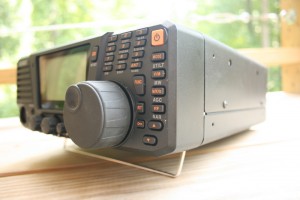 When people write in and ask for advice on buying their first tabletop receiver, I can recommend this DX-R8T without hesitation. Though it lacks the DSP that can be purchased separately with an Icom R75, it’s as sensitive as my Palstar R30C and the 9kHz AM bandwidth lends some excellent fidelity into headphones or an external speaker.
When people write in and ask for advice on buying their first tabletop receiver, I can recommend this DX-R8T without hesitation. Though it lacks the DSP that can be purchased separately with an Icom R75, it’s as sensitive as my Palstar R30C and the 9kHz AM bandwidth lends some excellent fidelity into headphones or an external speaker.
I must admit, I’m impressed with the Alinco DX-R8T. It has all of the major features I like in a tabletop radio: it’s well-built, easy to use, sensitive, versatile, and it has sufficient control options to help adjust adjacent interference and improve intelligibility. It also has a very attractive price at $499 US. It’s next-best competitor is probably the Icom R75–but neither the Icom, nor the Palstar R30A, can be used as an SDR and neither have the appropriate IF output for DRM as does the Alinco DX-R8T. In short, it’s a lot of radio for the money, excellent for those starting in the hobby.
Paired with a good antenna, the Alinco DX-R8T is a bargain performer. If you’ve thought about moving from portable radios to the world of a more serious receiver, you can’t go wrong with the Alinco DX-R8T.
––
Want to hear what audio from the Alinco DX-R8T sounds like? Here is a 2+ hour sampling of Radio New Zealand International recorded 02 Sep 2011:
Resources
- The Alinco DX-R8T entry in our Shortwave Radio Index which contains more reviews, options for purchasing and technical specifications.
- GRE America – US distributor of the Alinco DX-R8T
- Universal Radio

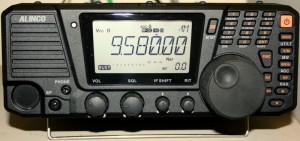
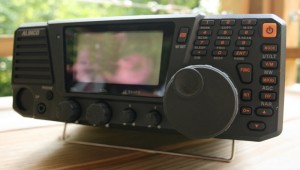
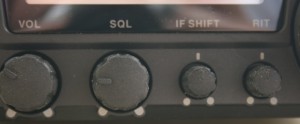
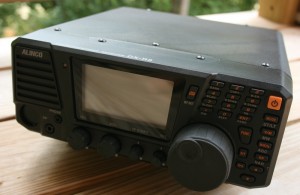
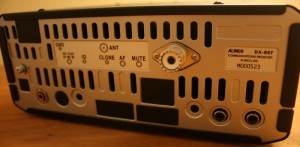
If you live in an area with plenty of open land around, a 500-to-1000-foot wire (or longer) laid on the ground with the end pointing in the direction of the signals you want to hear will work better than anything else I’ve tried. I fed the (receiver) end of the wire with a 6:1 impedance transformer and the wire is worked against a ground stake. The low impedance winding on the 6:1 transformer is connected to 50 ohm (or 75 ohm) coax which goes into the receiver. The second-best choice is probably a loop if you live near a city. An active whip designed for longwave will work effectively ONLY if you are not near a city or town with radio stations. The whip will be very susceptible to broadcast intermod.
Years ago when there were still European broadcasts in the longwave spectrum, a friend and I would roll out a 1/2 mile wire on the ground in the local desert pointed NE from Tucson. Right around sundown in the winter the stations from Europe and northern Africa would start coming in. It was incredible!
Frank
W7YAZ
Tucson
Since there is no ferrite rod antenna on this receiver, what would be the most affordable and efficient MW and LW antenna for it?
On SW, I use passive and 1/4 antennas which work very well.
Hi, I have been thinking about getting this radio as I find scanning on HF an invaluable feature but in the end opted for the cheaper Tecsun S2000. However when the S2000 scans there is a kind of chuff sound as it moves onto the next frequency which can be quite fatiguing after 20 minutes or so. How is the Alinco in this respect? Thks. 73 Adam M6RDP
My daughter bought me one a few years ago as a birthday present. And I’ve used it nearly every day since.
I was so happy with it I sold my Yaesu FRG-100 and my Kenwood R-5000. It does make sense to sell them and focus on the one radio. Especially given how happy I was with the Alinco.
For general HF coverage use I haven’t felt the need to replace any of the stock filters.
Audio quality was improved simply by going to and external amplified speaker (same Realistic speakers I’ve had since I was a teenager).
just acquired a used model at a good price… the IF shift works for at least one musically oriented AM BCB station in my area… i use it to adjust the treble! works FB… am very pleased with this simple receiver… if you remove the top cover you will see there is plenty of room for an internal battery pack!
The IF shift does work in AM mode, however, the Murata 455G type AM bandpass filter is too wide to notice it. I replaced mine with a 455I type which is available from Mouser but listed as a 455J in their on line catalog for some reason. The IF shift works great with this filter and the overall audio degradation is not that much due to the narrower bandwidth (about 5 kHz). Just be damn careful if you try to replace it, because the surrounding surface mount parts are very tiny and fragile.
Frank
K3YAZ
You’re right. I have use IF shift with R75 for clearer audio when using 2.4kHz narrow filter, and it usually sounds better with 455kHz IF than 9 Mhz.
You mention using the IF shift on AM mode broadcasts, to help with interference from another close station. Yet the manual says that IF shift is disabled for AM and FM mode. Is this true?
Yes, that’s true. My If shift does not work in AM mode. Why Alinco done that is beyond me.
Still toying with the Alinico vs Icom R75, both seem very good. I want it for MW . SW listening , and HF Aero. Is the AM filter as bad as I hear on all the reviews. or are icom fans nit picking ?
an otherwise ok modern R75 replacement? The r75 is not available new here in the UK any longer,
but the R8500 is ?
Also can other software such as HDSDR control the radio, as from what I can tell if
the IQ output is chosen then the controls and speaker are disabled, if not can you tune the rx normally are use HDSDR at the same time? KGSDR looks pretty basic, and does nothing to sell the SDR aspect of the rx
(posted on the sdr review also)
Thank you
Hi,
I’d like to know whether the Alinco DR-8 has lower noise floor on AM mode than the ICOM IC-R75. I have the latter, and I’m disappointed with it in this regard. I compard the R75 to a SONY ICF-2010, DEGEN DE1103 and an old Panasonic DR49/RF-4900lbs and they all performed better than R75.
I like to scan with RF attenuator. I check QRN, bring it down to S1 and then look out for any pop out on the S-meter or that thump when RF amp works when using headphones. With the R75, it does not work that way.
My R75 is the my best radio for SSB and other modes, but disappointed me on AM mode. And most of my DXing is on AM mode HF.
I’m even checking a Kenwood TS-990s transceiver.
Julio Cesar Pereira
PY5136SWL
Terra de Areia-RS, Brasil
Over the past few years I have had several Icom R75s (two with KIWA mods) and several Alinco DX-R8 receivers and I now only have the DX-R8. I found the sensitivity to be about the same on both, but the DX-R8 definitely was a quieter receiver with a slight edge on the signal-to-noise ratio over the R75. The R75 all sounded “hissy” to me. The stock AM filters in both receiver were “barn door” wide, but the dual IF shift in the R75 did allow some manipulation of this. In the DX-R8, I removed the Murata “G” type AM wide filter and replaced it with a drop fit “I” version which can found at Mouser Electronics for about $4.00. For some reason Mouser calls it a “J” filter which is an incorrect label per the catalog. The equivalent “H” filter will also work but with less effective adjustment range on the IF shift control. I do admit that the “H” has a little better audio fidelity than the “I” filter but I don’t find the latter’s audio objectionable. If you want selectivity, use the “I” type filter. CAUTION: make sure you have experience with surface mount soldering before you make the change, OR, have someone that has experience with SMD boards do it for you. It’s very easy to damage some of the tiny SMD components on the back side of the board near the filter if you are not careful.
Así se capta a The Disco Palace, en modo digital DRM!!!
Uds. califiquen el audio….
Audio corresponde al 17 Nov. 2012, de 20:28 a 20:59 por los 17875 KHz.
Decodificado por el programa Dream y con receptor Alinco DX-R8T
This is an audio recording by my Alinco DX-R8T receiving DRM mode, The Disco Palace. Great Audio fidelity!!! Regards from Mexico!
http://www.esnips.com/displayimage.php?pid=34245400
really….
Now lets talk ICOM 8500 for that 🙂
I fully agree with this test report! But if you don´t want to do DRM-receiving I strongly recommend to change the wide AM-Filter with a Murata CFK 455I (4KHz) or CFK 455H (6KHz) or equivalent. The Alinco DX-R8 has enough space (and drilled holes) for the Collins mechanical filters! With the 6KHz Collins my Alinco does a great job!
Herbert
Herbert
Can you email me those details for changing the filters… sound ideal, would really lift the rx up , did you do it yourself ? whats the procedure, what do I need .. ?
[email protected]
I contacted my supplier and they are unaware or unable to do the work .. I am in southern England uk ?
What is the minimum tuning step? What is the range of the RIT, the IF Shift? IOW, How well does this receiver work for ECSS?
Hi, Mark,
Down to .01 kHz tuning increments. RIT is +/- 1.2 kHz. In my experience, it does an excellent job with ECSS.
I will have to look on the spec sheet RE: IF shift.
Cheers,
Thomas
My tuning knob is pretty firm, but it was a very early model of the radio. I think the knob (and I rarely say this) is a little too large (especially compared with the size of the keypad). Thanks for your feedback.
Thank you, I would be interested in other peoples feed back, I often think of getting the radio again but rearly put off by that wobbly axis I had on the tuning knob, I was told thay are all like that? A good few mil of play up and down, Maybe its not the case?
I have an ICOM 7400 and excaliber SDR I now use for SW, but looking for a simple switch it on and listen set for the shack\
Maybe the Eton Satilite 750 ?
Go for an Icom IC-R75…it’s older compared to the Alinco and lacks features like IQ output, but it still does the job perfectly 🙂
“lacks features like IQ output”
The software provided for the alinco is very “crude” and no where near up to the levels of most other free SDR packages such as HDSDR, SDRadio etc. Also I could not find anyother package that could control the Alinco, so using any other packages was difficult. So you are not missing much
I feel that if you want an SDR radio get an SDR 🙂
Would still get one for a table top reciever (If I can get one with a firm Knob! ….oh err )
I agree its a great radio, but the tuning know seems “wobbly” on its axis, as if there are rubber washers in there .. Feels cheap
I got rid of for that reason,
Anyone else had the same, or was I unlucky
Mine is a bit “wobbly” too, looks like every Alinco DX-R8 is built like this. Anyway, I’ll keep it as it’s still a perfect overall receiver